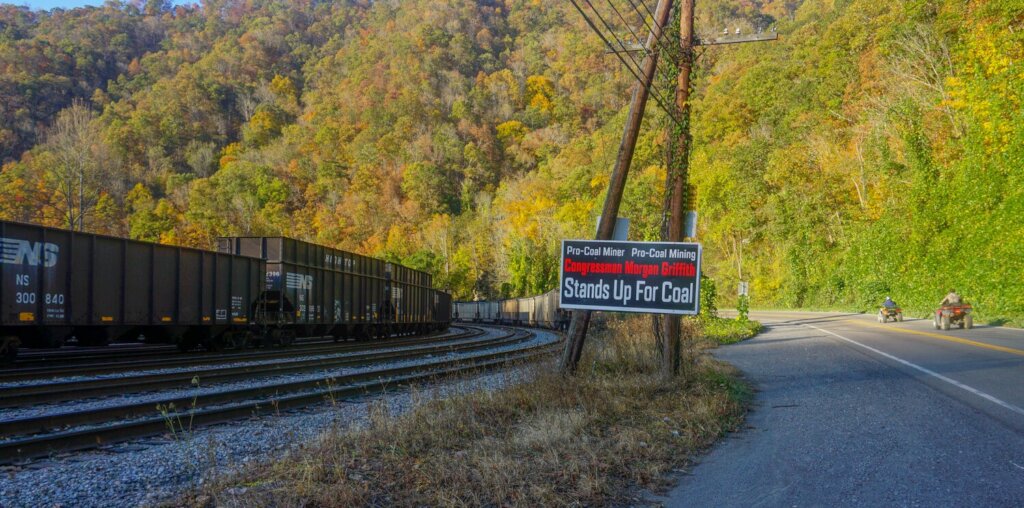By Grace Shawah | HAF-UVA Intern
Clean energy is the future, but embracing the change comes as a struggle for the four million individuals employed in the American fossil fuel sector —seen locally in Virginia’s coal-dominated Buchanan county. While jobs are being created in the rise of clean energy, the transition is not quick enough for those threatened with unemployment in the non-renewable energy sector.
The American government and international administrations continue pushing the clean energy agenda to reach global goals that minimize carbon emissions and halt temperature rise. Beyond just environmental concerns, nonrenewable sources are approaching threateningly low levels: global consumption rates project crude oil supply to run out in 50 years and natural gas to run out in the next 100 years.
Substitutes must be found to replace these nonrenewable sources for both consumers and workers whose livelihoods depend on them. As lawmakers continue to heavily pursue the clean energy transition, those employed in the fossil fuel industry have begun to feel heavy repercussions, evident in the coal-heavy towns of Western Virginia in the Appalachian region where 60% of coal jobs have disappeared since 2012.
So the question remains: how should this transition be addressed? It is evident that clean energy must be pursued, but how should we go about minimizing job loss during the transition?
Let’s first analyze what would happen if no action were taken to address the problem. Without any buffer, individuals in these coal-dependent towns will lose their jobs and be left with few employment options. To make matters worse, many of these Virginia residents lack training in other industries, and the Virginian economy will be hit hard as a consequence of unemployment with larger effects on lower-income households. Those with opportunities outside the blue-collar fossil fuel industry will be able to find other places to work, but many of those in the smaller coal-mining towns will be impacted disproportionately.
Legislation that provides economic buffers to those affected could be one alternative. Implementing a type of public benefit program will help diminish the immediate economic shock of unemployment in many of these smaller, coal-based towns, and will reduce opposition toward the clean energy agenda.
Seen during the onset of the COVID crisis, these financial buffers can come in the form of redistributed money from the government—such as stimulus checks or unemployment insurance—all gathered from taxpayer dollars. Checks would be targeted at those in these coal-dependent towns who we see getting hit the hardest.
Social safety net programs like these shouldn’t be too difficult to implement either since the unemployment program policy mechanism is mostly in place. However, the downside of this solution is the temporary aspect of it; people will not be incentivized to return to work if they are able to live comfortably off the government-provided cushion.
Another alternative gaining a fair amount of attention involves teaching trades related to the renewable energy sector. Implementing programs aimed at teaching clean energy skills would entail money being funneled into curriculum at community or state colleges, seen in Virginia’s Southwest Community College’s certificate in Renewable Energy and Energy Efficiency. The outcome of a diversified and well-paid workforce that wouldn’t depend on their fossil fuel sector jobs will justify the initial cost.
Many will be able to gain access to this sort of skill-learning regardless of their prior relationship with higher education. The Philippines recently passed a Green Job Act resembling this proposal that aimed at “providing specific financial incentives for green job creation, tax deductions for skills training, research and development for green jobs” and more. If policymakers can redirect opportunities to the renewable energy sector, they will keep more people in jobs and subsequently garner more support for their clean energy agenda.
Green-skilling the American workforce parallels USAID’s Farmer to Farmer Program (F2F) in Morocco, aimed at training farmers in skills related to sustainable agriculture as a means of creating more jobs and stimulating innovation and economic growth. The F2F program assists in practices beyond just crop production; it touches upon areas aimed at food security, good governance, women’s employment equality, and minimizing greenhouse gas emissions. Both green-skilling in the United States and F2F in Sub-Saharan and Northern Africa will drive growth in the sustainability sector and produce benefits for citizens and the environment.
It is important for action to be taken to ensure that the transition to clean energy doesn’t leave fossil fuel-employed Americans abandoned and unequipped, and as reflected in Morocco’s recent F2F initiative, the impacts of sustainability initiatives are far-reaching. Renewable energy is the future, and ensuring that the transition to this industry will be smooth for all parties involved is crucial to the amount of support it receives.
Project reports on GlobalGiving are posted directly to globalgiving.org by Project Leaders as they are completed, generally every 3-4 months. To protect the integrity of these documents, GlobalGiving does not alter them; therefore you may find some language or formatting issues.
If you donate to this project or have donated to this project, you can recieve an email when this project posts a report. You can also subscribe for reports without donating.
Support this important cause by creating a personalized fundraising page.
Start a Fundraiser